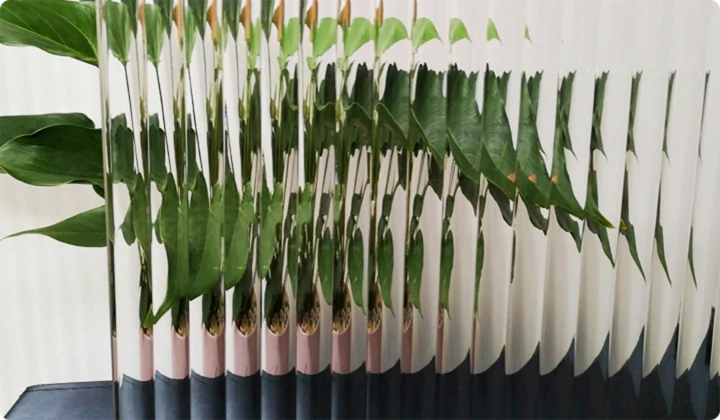The Float Glass Production Process A Comprehensive Overview
The float glass production process is a highly efficient method used to manufacture flat glass, which is essential for various applications such as windows, mirrors, and automotive glass
. This method was developed in the mid-20th century and has since revolutionized the glass industry due to its ability to produce high-quality glass sheets with excellent optical clarity and uniform thickness.
The process begins with the preparation of raw materials, primarily silica sand, soda ash, and limestone. These materials are carefully blended in precise proportions to create a homogeneous mixture, which is crucial for ensuring consistent glass quality. Other additives may also be included to achieve specific properties, such as improved durability or reduced thermal expansion.
Once the batch is prepared, it is introduced into a furnace. The furnace is typically heated to temperatures between 1,600 to 1,700 degrees Celsius, where the raw materials undergo a transformation into molten glass. This melting phase is critical, as it allows the materials to interact chemically and physically, resulting in a uniform glass composition. The molten glass is maintained at high temperatures to keep it in a workable state for subsequent processing.
float glass production process
After the glass has melted, it is poured onto a bed of molten tin in a controlled environment. This step is where the float in float glass comes from. The glass flows on top of the tin, which serves as a stable substrate. The difference in density between glass and tin causes the glass to spread out evenly, forming a smooth, flat surface. This unique process not only contributes to the uniform thickness of the glass but also enhances its optical properties, minimizing distortions.
As the glass moves along the float line, it begins to cool gradually, a phase known as annealing. During annealing, the temperature of the glass is slowly reduced to relieve internal stresses that develop during the cooling process. This stress relief is vital for ensuring the strength and durability of the final product. The annealing lehr, a long, heated tunnel, is used for this purpose, allowing for a controlled cooling rate that ensures optimal glass quality.
Once the glass has cooled adequately, it undergoes various finishing processes. These may include cutting the glass sheets to desired sizes, polishing edges, or applying coatings for additional features such as solar control or low-emissivity properties. Quality control measures are strictly implemented throughout the production process to ensure that the final product meets industry standards.
In summary, the float glass production process is a systematic and meticulously controlled method that yields high-quality flat glass. Its efficiency and ability to produce glass with superior optical clarity make it indispensable in today’s glass industry. As technological advancements continue to evolve, the float glass process is expected to maintain its significance, adapting to meet the demands of modern architecture and design.
 Afrikaans
Afrikaans  Albanian
Albanian  Amharic
Amharic  Arabic
Arabic  Armenian
Armenian  Azerbaijani
Azerbaijani  Basque
Basque  Belarusian
Belarusian  Bengali
Bengali  Bosnian
Bosnian  Bulgarian
Bulgarian  Catalan
Catalan  Cebuano
Cebuano  Corsican
Corsican  Croatian
Croatian  Czech
Czech  Danish
Danish  Dutch
Dutch  English
English  Esperanto
Esperanto  Estonian
Estonian  Finnish
Finnish  French
French  Frisian
Frisian  Galician
Galician  Georgian
Georgian  German
German  Greek
Greek  Gujarati
Gujarati  Haitian Creole
Haitian Creole  hausa
hausa  hawaiian
hawaiian  Hebrew
Hebrew  Hindi
Hindi  Miao
Miao  Hungarian
Hungarian  Icelandic
Icelandic  igbo
igbo  Indonesian
Indonesian  irish
irish  Italian
Italian  Japanese
Japanese  Javanese
Javanese  Kannada
Kannada  kazakh
kazakh  Khmer
Khmer  Rwandese
Rwandese  Korean
Korean  Kurdish
Kurdish  Kyrgyz
Kyrgyz  Lao
Lao  Latin
Latin  Latvian
Latvian  Lithuanian
Lithuanian  Luxembourgish
Luxembourgish  Macedonian
Macedonian  Malgashi
Malgashi  Malay
Malay  Malayalam
Malayalam  Maltese
Maltese  Maori
Maori  Marathi
Marathi  Mongolian
Mongolian  Myanmar
Myanmar  Nepali
Nepali  Norwegian
Norwegian  Norwegian
Norwegian  Occitan
Occitan  Pashto
Pashto  Persian
Persian  Polish
Polish  Portuguese
Portuguese  Punjabi
Punjabi  Romanian
Romanian  Russian
Russian  Samoan
Samoan  Scottish Gaelic
Scottish Gaelic  Serbian
Serbian  Sesotho
Sesotho  Shona
Shona  Sindhi
Sindhi  Sinhala
Sinhala  Slovak
Slovak  Slovenian
Slovenian  Somali
Somali  Spanish
Spanish  Sundanese
Sundanese  Swahili
Swahili  Swedish
Swedish  Tagalog
Tagalog  Tajik
Tajik  Tamil
Tamil  Tatar
Tatar  Telugu
Telugu  Thai
Thai  Turkish
Turkish  Turkmen
Turkmen  Ukrainian
Ukrainian  Urdu
Urdu  Uighur
Uighur  Uzbek
Uzbek  Vietnamese
Vietnamese  Welsh
Welsh  Bantu
Bantu  Yiddish
Yiddish  Yoruba
Yoruba  Zulu
Zulu 

